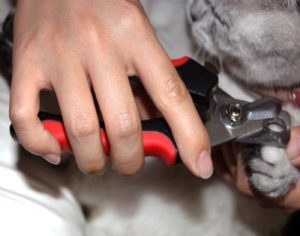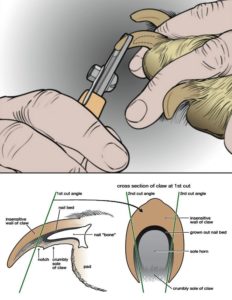
Trimming nails on dogs is often a hard-fought war, with bloody casualties on both sides. Because of that, many people leave the task to their groomer or veterinarian. But unless you’re seeing these professionals a lot more than most people do, your pet’s nails aren’t being trimmed often enough.
Long nails can make walking uncomfortable and can even cause lameness. This is why trimming nails short — they should be just off the ground when your pet is standing — and then trimming them just a pinch every week is a better way to go.
The problem with nails is that each has a blood vessel inside. The trick is to trim to just beyond the end of this vein. If you nick it, the nail will bleed, and your dog will yelp. Everyone hits this vein on occasion, even veterinarians, which is why you should be sure to have blood-stopping powder on hand, such as Kwik Stop, before you start trimming.
If your dog has light-colored toenails, the blood vessel is the pink area. Black nails are harder to figure out, but you should be able to see the vein by shining a flashlight behind the nail. If you can’t tell, just clip back a little at a time. If you draw blood, take a pinch of the powder and press it against the exposed bottom of the nail for a few seconds to stop the bleeding.
If your dog’s nails are so long that they’re forcing her foot out of position, you can take them back to where they should be in two ways. The first is to cut a little off every few days: The quick recedes before you as you go. The second way is to have your veterinarian take them all the way back at once when your dog is under anesthesia, such as for a teeth-cleaning. After the nails are at a proper length, keeping them that way is easy with a weekly trim.
If your dog is resistant to having her nails trimmed, work up to the task over a few weeks’ time by taking the trimmer in hand and touching it to her feet, then her toes, then the nails, while praising her and giving her treats for each step. When she is used to having her feet handled, put the trimmer against the nail and praise and treat more still. Then trim a little off, and so on. Praise and more praise! Treats and more treats! Don’t insist on getting all the nails done at once. Do one or two toes a night, and put the nippers away while both you and the dog are feeling positive about the experience.
An alternative to nail-trimming is nail-grinding. You can buy a canine nail grinder, or just use a lightweight rotary grinding tool, such as the Dremmel.
Some dogs prefer having their nails ground instead of clipped, perhaps because with a grinder it’s easy to stop before you hit the quick. The most important thing to remember when grinding is that nails can get hot while you’re working on them. Don’t grind continuously. Touch the grinder to the nail in very short bursts — a second or two at most — to keep the heat from building up. You can also file the nails, using an 8-inch “bastard wood rasp,” which is available at most home-supply stores.
Whatever method you’re using to shorten the nails, don’t forget the dewclaws, those extra toes you can find up on the inside of the leg. Not all dogs have them, but for those who do, neglected nails can be a problem. Long nails can catch on upholstery and tear the dewclaw partly off the leg. Keeping these nails short will prevent injury, which is why you haven’t finished trimming nails until you’ve done the dew, too.
Tags: #dog nail clippers

